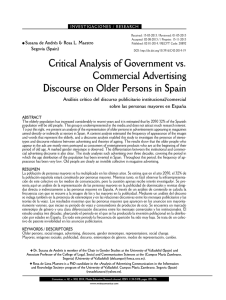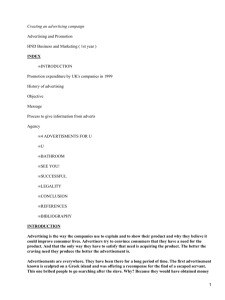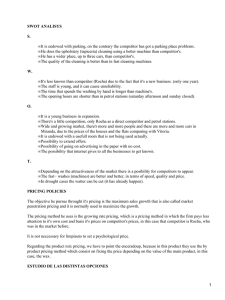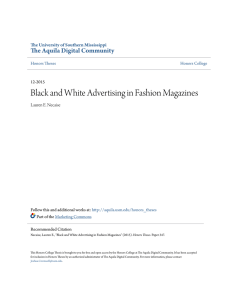Critical Analysis of Government vs. Commercial Advertising
Anuncio
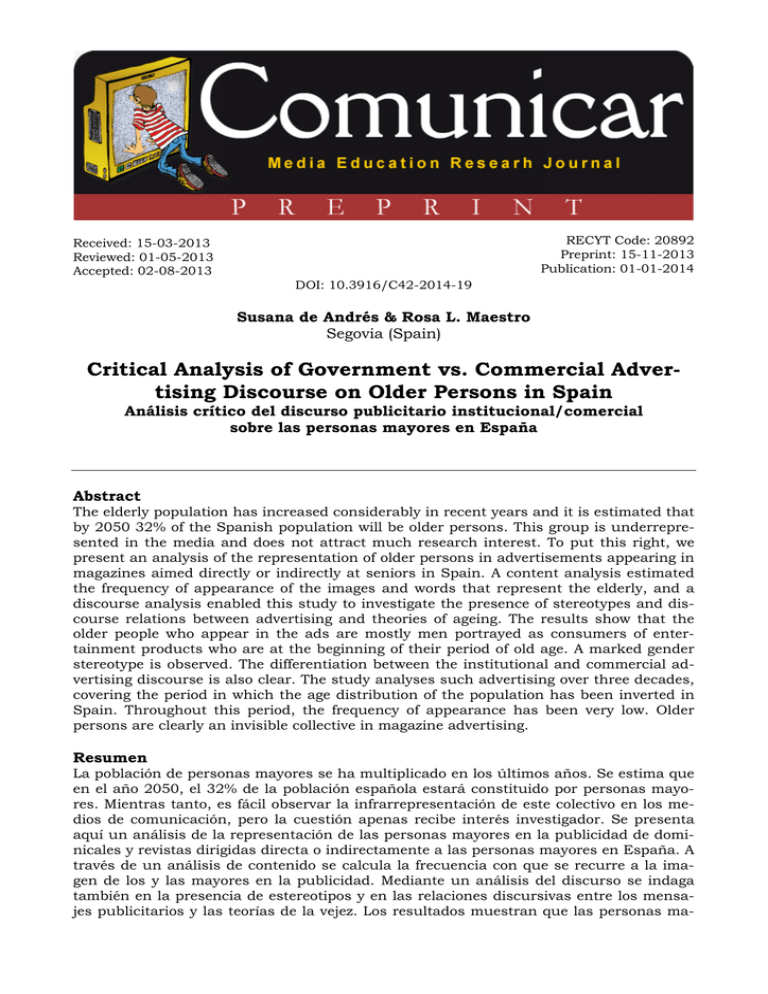
RECYT Code: 20892 Preprint: 15-11-2013 Publication: 01-01-2014 Received: 15-03-2013 Reviewed: 01-05-2013 Accepted: 02-08-2013 DOI: 10.3916/C42-2014-19 Susana de Andrés & Rosa L. Maestro Segovia (Spain) Critical Analysis of Government vs. Commercial Advertising Discourse on Older Persons in Spain Análisis crítico del discurso publicitario institucional/comercial sobre las personas mayores en España Abstract The elderly population has increased considerably in recent years and it is estimated that by 2050 32% of the Spanish population will be older persons. This group is underrepresented in the media and does not attract much research interest. To put this right, we present an analysis of the representation of older persons in advertisements appearing in magazines aimed directly or indirectly at seniors in Spain. A content analysis estimated the frequency of appearance of the images and words that represent the elderly, and a discourse analysis enabled this study to investigate the presence of stereotypes and discourse relations between advertising and theories of ageing. The results show that the older people who appear in the ads are mostly men portrayed as consumers of entertainment products who are at the beginning of their period of old age. A marked gender stereotype is observed. The differentiation between the institutional and commercial advertising discourse is also clear. The study analyses such advertising over three decades, covering the period in which the age distribution of the population has been inverted in Spain. Throughout this period, the frequency of appearance has been very low. Older persons are clearly an invisible collective in magazine advertising. Resumen La población de personas mayores se ha multiplicado en los últimos años. Se estima que en el año 2050, el 32% de la población española estará constituido por personas mayores. Mientras tanto, es fácil observar la infrarrepresentación de este colectivo en los medios de comunicación, pero la cuestión apenas recibe interés investigador. Se presenta aquí un análisis de la representación de las personas mayores en la publicidad de dominicales y revistas dirigidas directa o indirectamente a las personas mayores en España. A través de un análisis de contenido se calcula la frecuencia con que se recurre a la imagen de los y las mayores en la publicidad. Mediante un análisis del discurso se indaga también en la presencia de estereotipos y en las relaciones discursivas entre los mensajes publicitarios y las teorías de la vejez. Los resultados muestran que las personas ma- yores que aparecen en los anuncios son mayoritariamente varones, que inician su periodo de vejez y consumidores de productos de ocio. Se encuentra un marcado estereotipo de género y una clara diferenciación discursiva entre los mensajes comerciales y los institucionales. El estudio analiza tres décadas, abarcando el periodo en el que se ha producido la inversión poblacional en la distribución por edades en España. En todo este periodo la frecuencia de aparición ha sido muy baja. Se trata de un colectivo de patente invisibilidad en los anuncios publicitarios. Keywords / Palabras clave Older persons, social images, advertising, discourse, gender stereotypes, representations, social change. Mayores, imágenes sociales, publicidad, discurso, estereotipos de género, modos de representación, contextos de cambio. Dr. Susana de Andrés is member of the Chair in Gender Studies at the University of Valladolid (Spain) and Associate Professor of the College of Legal, Social and Communication Sciences at the (Campus María Zambrano, Segovia) (University of Valladolid) ([email protected]). Rosa de Lima Maestro is a PhD candidate in the «Analysis of Advertising Communication in the Information and Knowledge Society» program of the University of Valladolid. Campus María Zambrano, Segovia (Spain) ([email protected]). 1. Introduction. Old age will define the 21st century (and its form of communication?) One of the social changes that best describes our context is progressive population ageing. Global life expectancy has increased to 69.8 years of age, while fertility has dropped to 2.6 children per woman (UN, 2007). The population aged 60 and over is expected to triple, and those over 80 to quadruple by 2050 (UN, 2009). A global demographic transition appears to be underway. The elderly population is three times larger in developed than in developing countries, and these percentages will continue to grow (Giró, 2004: 30). Europe will soon have the largest population in the world in terms of old age. In Spain, life expectancy at birth has grown progressively from 75 years in 1980 to more than 81 in 2011. (UNDP, 2011) and Spain’s National Statistics Institute (INE) estimates that older persons will form at least a third of the population by 2050. By that date, the United Nations projects that Spain will be second only to Japan in the number of old persons (Barrio & Abellán, 2009). These statistics assume that old age begins at retirement age - 65. Thus, statistical indicators use economic and labor criteria to divide up the age segments. But when old age begins is arbitrary; other criteria (Giró, 2004: 24) put it at 50 or 55, taking into account biological, health economic and social changes, which only goes to show that old age is defined by social conventions: «We know that the problem of old age is not strictly a biological, medical or physical issue but social and cultural; that is to say, old age, its meaning, is a cultural construction» (Giró, 2004: 19). Old age is a social construction (Kehl & Fernández, 2001), a cultural fact (Beauvoir, 1989: 20), a matter of images and attitudes (Iruzubieta, 2004: 77). A specific field of study about the social construction of old age has been the analysis of its images and meanings (Featherstone & Wernick, 1995) and, more specifically, the images transmitted by the media (Santamarina, 2004). © COMUNICAR, 42 (2014); e-ISSN: 1988-3293; Preprint Edition DOI: 10.3916/C42-2014-19 A number of publications have pointed out the importance of the media in this social construction (Kehl & Fernández, 2001: 133) and recently, the analysis of older persons’ representation in the Spanish press has attracted particular interest (Polo, 2006; Becerril, 2011). At the Second World Assembly on Ageing held in Madrid in 2002, the then UN head Kofi Annan said that, since the previous Assembly in 1982, the world had changed so much that it was unrecognizable (UN, 2003: IV). This United Nations strategy called for governments and civil society to reshape the way older persons are perceived, expressly including the media (article 17: 6) as environment makers. The analysis of older persons’ representation in advertising is still not an object of specific study in Spanish scientific literature, though it has been researched in the USA since the 70s (Smith, 1976; Swayne & Greco, 1987). The different analyses show a stereotypical picture, often with negative connotations and underrepresentation in advertisements. 2. Research approach The present study aims to analyse how advertising discourse, with its particular structures and content strategies, has shaped the image or social role of older persons in recent decades. The objectives are the analysis of the visual and verbal representation of older persons in advertising, and the study of discursive divergences between commercial and institutional advertising. As a working hypothesis, this study considers the remarkable invisibility of older persons in advertising, one of the most numerous social groups in Spain. The aim is to quantify this visibility/invisibility in advertisements to test the hypothesis and then investigate a possible discursive difference between commercial and institutional advertising. An analysis of the main differences in the representation of men and women is also considered, anticipating a possible gender-based stereotyped treatment in advertising. This was done by means of an analysis of images and text. As a methodological guide to analyze this set of representations and discourses we used content analysis and critical discourse analysis (CDA), considering the definition by Van-Dijk (1999: 22): «Critical discourse analysis is a kind of analytic investigation on discourse that primarily studies the way in which the abuse of social power, domination and inequality are practiced, reproduced and occasionally combated by texts and speech in the social and political context. Critical discourse analysis, with such a particular investigation, explicitly takes sides, expecting to contribute in a more effective way to the resistance against social inequality.» Critical discourse analysis reveals communication acts that promote social inequality. It also reveals the distance in communication between emitter and audiences. In the advertisements analyzed, it is clear that their creators and decision makers are probably not older persons, so the advertisements’ discourse is a speech act about «them» or about «others». Mass media, including advertising, make it possible to establish a link between plural emitters representing social and economic powers (the state, corporations © COMUNICAR, 42 (2014); e-ISSN: 1988-3293; Preprint Edition DOI: 10.3916/C42-2014-19 and economic agents) and the audience who daily build and validate social concepts and self-concepts. Numerical data as well as relationships between advertising’s argumentation of private and public emitters and the models of old age they refer to will be extracted from the application of this mixed modeling. «Discourses are interpreted as elements with a coherent relationship to the users’ mental models about the events or facts they refer to», (Van-Dijk, 2003:165). It is known that discourse structures are related to context structures. Hence the usefulness of analysis categories which enable us to find relationships with social structures. This observation in advertising discourse provides a theoretical framework to study the present discursive production that asserts the present social status of older persons. In this study advertising messages are analyzed at micro level, to relate them to the macro level, in the framework of the theories of social gerontology. 2.1. Sample design Considering when a discourse becomes historical, this analysis covers an extended period of time (1980-2010) which can be considered a stage in communication history (Timoteo, 2012), a stage of economic study (Sanchís-Marco, 2011) and as a period of diachronic analysis in the recent history of international development1. This period corresponds to a progressive increase in the highest life expectancy rates in history and population ageing. The year 2001 was a turning point in the demographic history of Spain. Since then, the percentage of the population over 65 has exceeded the child population percentage. (Abellán & Ayala: 2012: 6). This study analyzes advertisements in the non-daily press in Spain. Specific supports aimed at older persons have been selected («Vivir con Júbilo», «Sesenta y más») as well as general supports with a larger readership of older persons (Sunday supplements such as «Blanco y Negro»2, «EPS: El País Semanal») and a magazine from the pharmaceutical sector (Acófar). All the advertisements that visually or verbally represent older persons have been collected. Non-repeated advertisements appearing within the stated period in all editions, in the case of monthly magazines, have been analyzed. In the case of weeklies, one copy per month has been selected. The total number of advertisements analyzed was 1,691. According to the AIMC (Spanish Association for the Investigation of the Media), people over 55 constitute 33.2% of the readership of supplements and 25% of the total readership of magazines (2011). This segment is a big consumer of general press media and is also a focus for institutional advertising, as pointed out in the 6th report of the Committee for Institutional Advertising and Communication in 2011. Advertising images and texts provide useful material for analysis as both projector and viewer of these constructions. It could be said that advertising acts as a converter of these ideas into images and representational conventions. These representations revert back to social imagery and can reshape our mental images. 2.2. Analysis model © COMUNICAR, 42 (2014); e-ISSN: 1988-3293; Preprint Edition DOI: 10.3916/C42-2014-19 When the study interest focuses on the analysis of the role of discourse in the reproduction of ideas about social groups, the forms of meaning must be analyzed. This requires a content analysis (Van Dijk, 2003: 149) that identifies the topics, propositions and elements selected. These three aspects have been identified as relevant for advertising discourse analysis regarding the role of older persons in our society. In terms of advertising’s construction of messages, correspondence has been established that includes topics or fields related to information or consumption, thematic proposals, and words or phrases related to old age. Such elements have been filtered in categories for an interpretative analysis of the observed content. Furthermore, images in which older persons are represented have been analyzed, taking into consideration the gender, age segment and appearance, either alone or living with other people. The type of emitter has also been analysed in order to make a comparative study between institutional and commercial advertising. 3. Results and analysis The following data have been drawn from the application of the content analysis model designed to facilitate a discourse analysis. These results are then related to the theories of ageing drawn from social gerontology studies, taking into account the remarkably interpretative character of the discourse analysis processes. (Íñiguez, 2006: 121). Several aspects of the context pointed out by Van-Dijk (1996: 30) have been integrated in the analysis model, such as subperiods of age, gender, lexicalization, descriptions of activity, proposition and topics (this last aspect has been incorporated into the present study and applied to advertising as a thematic proposal of the advertisement and area of consumption). 3.1. Invisibilities A key research finding is the patent invisibility of older persons in advertising, especially if we bear in mind that the supports analyzed are aimed at an elderly audience, in a specific or general way. After reviewing at least 35,000 advertisements, only 1,691 included any representation of older persons. Invisibility is perhaps the most common exercise of symbolic violence in communication when talking about disadvantaged groups. This is the case with older persons, which is even more unusual if we bear in mind that they are not a minority. In Spain the population pyramid is clearly inverted. Only 4.8% of the advertisements studied represented older persons3. It is also significant that in magazines exclusively aimed at older persons («Vivir con Júbilo», «Sesenta y Más») this percentage only reaches 27 and 40%, respectively. But we have to take into consideration that so-called old age covers a wide age range. It seems to include at least two or three intermediate age groups. Some studies make a distinction between old age and very old age (Sánchez Vera, 1996) or between «young old» and older old, an age that would begin at 80 («oldest old», in UN terms). This age range has seen the biggest increase in population terms in Spain. People over 80 represented 29% of the population over 65 in 2009, and it is estimated that they will soon be 36.8% of the total elderly population (IMSERSO, 2010: 32). In contrast, only 4% of the older persons represented in adver© COMUNICAR, 42 (2014); e-ISSN: 1988-3293; Preprint Edition DOI: 10.3916/C42-2014-19 tisements belonged to the group of the “oldest old”. Most images represented the young old (60%), from 60 to 75 years of age approximately. In their study, Bradley and Longino (2001) related this stereotype of young old to the so-called age mask hypothesis, according to which older persons see themselves as younger than they in fact are. This finding reflects the projective intention of advertising’s images and messages, and is a starting point for the debate on cognitive and biological age. Stephens (1991) talked about the usefulness and potential of the cognitive age concept for the creation of advertising targets. Functionalist theories of old age sociology explain that age classification is a structural element to which several functions are assigned. Advertising takes account of this logic in the framework of the age stratification theory, according to which self-esteem at each stage is conditioned by the roles it plays (Belando, 2007). The thematic proposal of advertising messages is fun, relaxation or hope in the case of the young old, and becomes a proposal for assistance in the oldest age range. Self-esteem and autonomy are persuasive arguments aimed mainly at the young old. The invisibility of persons in the “oldest old” range in commercial advertising as well as its relation to the idea of dependency is a characteristic of «ageism» (Fernández-Ballesteros, 2011: 138), or discrimination towards that social group. Table 1. Number of main figures represented. Total frequencies by age group and the promise projected in the message Age group Thematic proposal (promise) 60-70 70-80 Various Over 80 Assistance, functional 81 79 13 24 Self-esteem 85 13 5 1 Autonomy 46 17 4 Fun, relaxation, hope 138 43 13 Information, awareness 50 38 14 3 Total 400 190 49 28 Total 197 104 67 194 105 667 3.2. Lexical study. Old age: an advertising taboo Invisibility is also apparent in advertising texts. The work of the copy writer seems to be to avoid mentioning old age explicitly. As a consequence, older persons are not mentioned in advertising, and 56.6% of advertisements whose subject is older persons avoid mentioning any words that identify them as such. In the cases in which it is lexicalized, they use the word “mayores” (seniors), in 8.9% of cases, or the description of the age: elderly, golden age, a man who has aged well, etc. (3.7%). Neither the words “old age” nor words in the same lexical family appear, not even in advertisements aimed at that age group. In contrast, it is easy to check how the words “old age” and others related to an elderly physical appearance such as wrinkles, white hairs and flaccidity are common in adverts for female cosmetics. Old age has become a term used in the advertising model of consumerism in the context of fear of ageing4. This paradox shows that the repre© COMUNICAR, 42 (2014); e-ISSN: 1988-3293; Preprint Edition DOI: 10.3916/C42-2014-19 sentation of images of older persons in advertising is not linked to the use of the term that identifies them, rather, the word “old age” appears next to images denoting youth. 3.3. Older persons and the representation of their dependency / independence Institutional advertising tends to represent the older person in the company of others, as was the case with 49% of the institutional advertisements analyzed, while only 30% showed the older person alone. The issue of the social creation of dependency in old age has already been discussed5, and this is the idea behind the discourse of institutional advertising. One of the theories of the sociology of gerontology arises from symbolic interactionism and goes by the name of labeling theory. From that perspective, one of the labels assigned to older persons is dependency (in the sense that it is a kind of anomaly). Table 2. Number of main figures represented. Total frequencies by type of advertiser and representation of the older person in relation to others. Representation of the older person in relation to others Type of advertiser In family/others, with people of different ages Couple Alone Total Political advertiser 1 1 1 3 Private, commercial 163 89 216 468 Institutional 61 26 38 125 Social: NGO, foundation… 28 17 26 71 Total 253 133 281 667 In contrast, the analysis of advertisements made by private and commercial advertisers revealed that 65% represented an older person alone or in a couple. They are the «young old», independent people, a representation far removed from the stereotype that relates old age to dependency. Such occurrences are broadcast mainly in the form of commercial advertising and tend to exclude very old people. 3.4. Gender stereotypes in the representation of older persons Despite the fact that the increase in life expectancy brings about the feminization of the elderly population, only 23.6% of the advertisements have a woman as the main character, compared to 44% with a man as the protagonist. This percentage is similar in institutional and commercial advertising, the latter featuring a higher percentage of women as the main character (23.7%) with 20.8% in institutional advertising. In 1979, Susan Sontag discussed double standards in ageing, a social order that seems to persist in images of old age. In the advertising analyzed, the man appears enjoying leisure activities in company whereas the woman is often alone, in need of health assistance services. The profile of the elderly person is also feminized in advertising. Of the 28 advertisements examined in which a very old person appeared, 26 featured a woman rather than a man. © COMUNICAR, 42 (2014); e-ISSN: 1988-3293; Preprint Edition DOI: 10.3916/C42-2014-19 The range of products and services in adverts for older persons is highly differentiated by gender. Almost all the drinks advertisements feature a man, while most health and beauty products have a woman. In relative terms, women have a greater presence in advertisements for assistance and health products6. Men are more prominent in advertising for leisure products7, culture and even for clothes and accessories. This finding can be easily explained in the context of the current model of consumerism which is generally segmented by gender. However, there is more equality in institutional advertising in quantitative terms with 43% of institutional advertisements representing a man and a woman together, compared to 28% in commercial adverts). As typically happens in discourses about otherness, older persons are described only in vague terms. The representations we have analyzed tend to generalize and few of them present the individuality or personality of the old person, and even less so in the case of women. Descriptive images are often file pictures that coldly define the Western type of older person. The representation of celebrities is the only case in which older persons’ identity and personality have not been stolen, and the vast majority of the celebrities represented are men. 3.5. Intertextuality. Discussion on the relations between advertising discourse and theoretical models of old age The findings of this study reveal a link between the discourse of institutional advertising and the functionalist paradigm of the sociology of old age. In this paradigm, the image of old age is a social problem «resulting from mandatory retirement, structural changes in the family and industrialization and urbanization processes, the emphasis on the individual adjustment to ageing» (Giró, 2004: 20). The institutional discourse presents the «official» program of activities suitable for older persons (IMSERSO trips, club cards, programs to learn new technologies, etc.). It can be linked to the functionalist theory that considers retirement as a stage marked by creative leisure: «the theory of activity is based on a very optimistic and in some ways idealistic view, as it hands the elderly population a solution to their problems which actually depends exclusively on the social, economic and political structures». Public administration advertising has raised the visibility of the oldest. The image of very old persons, with no recognized activity and represented in company or in need of the help of others, reflects a functionalist idea that is economic in nature when associating old age with retirement or lack of activity. It is related to the discursive perspective that promotes the social creation of dependency in old age (Alan Walker’s thesis). This has economic implications, as retirement is considered to be «a social death, like the denial of the right to work», and it is also believed to promote an economy of social assistance that represents the «environment» and the idea of welfare in public policies on old age: The «Action Plan» is based on three pillars: the aged and development, promotion of health and welfare in old age and the creation of a suitable environment. It constitutes the benchmark for policy formulation and calls on governments, NGOs and other interested parties to redirect the way in which citizens perceive © COMUNICAR, 42 (2014); e-ISSN: 1988-3293; Preprint Edition DOI: 10.3916/C42-2014-19 the aged, interact with them and assist them» (UN International Plan of Action on Ageing, World Assembly, Madrid, 2003: IV), For its part, commercial advertising seems to promote the postmodern perspective of ageing and the creation of lifestyles that are not based on productivity but on consumption (Giró, 2004: 23). This approach is closer to the idea of a cultural construction of the aged through consumption, contrary to a place that is institutionally assigned. After analysing eleven categories of products or services advertised, two categories appear as the most widely publicized: assistance and help products and/or services (17.7%) and leisure products/services (12.2%). The same happens with the thematic proposal of the messages. Of the five categories analyzed, the vast majority of advertisements include a functional proposal8 such as assistance (29.5%) or a fun or relaxation proposal (29%). This can be summarized as two ideological constructions of old age: one that equates old age with loss of autonomy (increasing dependencies) and the other that associates this age to leisure and relaxation. Advertising discourse, be it institutional or commercial, actively promotes the idea of assistance for an age range that needs practical, functional support and objects that provide this. Public administrations choose fun and relaxation as a thematic proposal in many of their advertisements (36% of cases). Therefore, the institutional message would connect with the so-called «disengagement» theory that defines retirement as something desirable (Kehl & Fernández, 2001: 147), an idea that was quickly rejected on the theoretical level, but one which makes sense in an idealistic advertising discourse. Table 3. Frequencies of advertisements by type of advertiser and promise of the message Type of advertiser Thematic proposal to the Commercial Institutional reader (promise) % of ads % of ads advertiser advertiser Assistance, functional 156 33.3 19 15.2 Self-esteem 92 19.7 6 4.8 Autonomy 50 10.6 13 10.4 Fun, relaxation, hope 133 28.4 45 36 Information, awareness 37 7.9 42 33.6 Total 468 100 125 100 4. Conclusions and challenges The tradition of consumption associated to gender is deeply rooted in advertising aimed at older persons. Hygiene, health and beauty are associated with women, while culture and alcoholic drinks are associated with men. Commercial advertising raises a relational concept of old age and consumption. The advertising idea of old age deepens the gender gap in commercial advertising, following the old age approach pointed out by Sontag (1979). The relation between the advertising discourse on older persons and the functionalist paradigm is clear, especially in the case of institutional advertising, which © COMUNICAR, 42 (2014); e-ISSN: 1988-3293; Preprint Edition DOI: 10.3916/C42-2014-19 is close to the «disengagement» theory. For its part, commercial advertising’s proposal shows a young old consumer, which can be linked to postmodernity theories that blur the limits of old age and lifestyles based on consumption not productivity (Giró, 2004: 23). This theory strongly promotes the possibility of empowering older persons in anticipation of their future social role: «The immediate future, with the unstoppable increase in the number of aged persons, is going to have to deal with structural and perspective changes in the social value of ages, to the point of predicting that social and political power will rest in the hands of mature and aged people». The old age discourse in advertising is a duality and clearly depends on the type of emitter. Institutional advertising increasingly represents old people in couples. The result is clearly contextual. According to INE data, the majority of older persons are married and the rates of widowhood have significantly decreased. However, the most widespread discourse is the one proposed by the commercial emitter, which offers all kinds of functional products to make up for the loss of physical capacity. This model of consumption is probably based on a subjective definition of old age understood as loss of autonomy. Camps (2003: 268) states that old age is characterized, above all, by the loss of autonomy, a fact that has been used by advertising in its discourse. Discursive strategy is now no longer based on the fear of ageing, but on the fear of losing capacity and autonomy. This is the implicit message of commercial advertising aimed at older persons. Advertising, defined as persuasive discourse, shows its ability to transfer meanings related to the old persons’ social role. Not for nothing does Van-Dijk (2003: 166) point out that persuasion, in the broad sense, is defined by control over the terms of social representations. It can be safely said that old age is the great opportunity for advertising communication and marketing. With an inverted population pyramid whose base is progressively diminishing while the top gets ever wider, the big market in quantitative terms will be older persons. There is also greater media consumption at that age. But one of the questions that arises from these findings is: will the advertising machine continue to publicize an image of older persons as a minority? And more important, will it dare to discard the discourse of fear, of loss of autonomy and embrace a constructive discourse that progressively prepares people in each of life’s stages for the arrival and acceptance of old age? The expectation of an old age rich in possibilities for development and personal growth would not only be culturally but also commercially progress. Only through the construction of a more attractive idea of old age that is plural, diverse and positive will it be possible to impart an experience of senior citizenship that can be appreciated. Hiding and stereotyping images of old age only serves to weaken the bases of the new culture that needs to be built in this century of the old age person. Some communications studies anticipated that the myth of youth widely disseminated by advertising would soon be replaced by «the silver power » (MartínezPais, 1999: 73), since the myths spread by the media belong to the economic and sociological market and its various contexts, but this rational prediction has failed to materialize. © COMUNICAR, 42 (2014); e-ISSN: 1988-3293; Preprint Edition DOI: 10.3916/C42-2014-19 Notes There are several reports on socio-economic analysis, trends and development in this period, such as the UNDP report on Human Development or the CEPAL report. 2 The Blanco y Negro supplement has been analyzed up to its final edition in December 2001. «EPS» and «Sesenta y más» have been analyzed since their first editions, in 1981 and 1984 respectively. 3 In Spain, the percentage of older persons ranged from 11.2% in 1980 to 17.9% in 2010. Data from INE (the Spanish National Statistics Institute). 4 For instance, advertising for the product Revitalift by L’Oréal makes the following promise: «Combat 10 signs of ageing» (www.loreal-paris.es/cuidados-de-la-piel/cuidadofacial/revitalift/revitalift-total-repair-10.aspx) (18-02-2013). 5 Walker, A. (1980): The Social Creation of Poverty and Dependency in Old Age. Journal of Social Policy, 9 (1), 49-75, quoted by Giró (2004: 22). 6 11% of the advertisements that represented a woman as the main character advertised health products, compared to 5.4% of the advertisements with a man as the main character. 31% of the advertisements with a woman as the main character promoted assistance products, compared to 19.5% of the advertisements with a man as the main character. 7 91.4% of the advertisements of leisure products presented a man. In the case of advertisements of cultural products there was only one woman as the main character. 8 Hearing aids, residential centres, telecare services, etc. 1 References AIMC. (2011). Resumen general EGM. Año móvil febrero a diciembre 2010. (www.aimc.es/-Datos-EGM-Resumen-General-.html) (10-12-12). Abellán, A. & Ayala, A. (2012). Un perfil de las personas mayores en España. Indicadores estadísticos. Informes Portal Mayores, 131. Madrid: IMSERSO, CSIC, CCHS. (www.imsersomayores.csic.es/documentos/documentos/pm-indicadoresbasicos12.pdf) (20-01-2013). Barrio, E. del & Abellán, A. (2009). Las personas mayores en España. Indicadores demográficos. Informe 2008. Madrid: CSIC, Fundación IGEMA. (www.imsersomayores.csic.es/documentos/estadisticas/informe-mayores/2008/volumen-1/00informe-personas-mayores-2008-vol-01.pdf) (10-12-12). Beauvoir, S. de (1989). La vejez. Barcelona: Edhasa. (1ª ed. La Viellesse: Gallimard, 1970). Becerril, R. (2011). Cuerpo, cultura y envejecimiento. Análisis de la imagen corporal en la publicidad «60 y más» (IMSERSO). Ágora para la educación física y el deporte, 13 (2), 139-164. Belando, M. (2007). Modelos sociológicos de la vejez y su repercusión en los medios. Reconstruyendo identidades. Una visión desde el ámbito educativo. In L. Álvarez & J. Evans (Eds.), Actas del Foro Internacional Comunicación e Persoas Maiores (pp. 7794). Santiago de Compostela: Colegio Oficial de Xornalistas de Galicia. Bradley, D. E. & Longino, C.F. (2001). How Older People Think about Images of Aging in Advertising and the Media. Generations, XXV, 3, 17-21. (www.50plus.kro.nl/data/media/db_download/21_b4443a.pdf) (12-01-2013). Camps, V. (2003). La vejez como problema y como oportunidad. Gerontol, 13 (4), 267270. Comisión de publicidad y comunicación institucional (2011). Plan de comunicación y publicidad institucional 2011. Madrid: Ministerio de la Presidencia. (www.lamoncloa.gob.es/ConsejodeMinistros/Enlaces/210111-enlacepubli.htm) (20-11-2012). © COMUNICAR, 42 (2014); e-ISSN: 1988-3293; Preprint Edition DOI: 10.3916/C42-2014-19 Fernández-Ballesteros, R. (2011). Limitaciones y posibilidades de la edad. In IMSERSO. Libro Blanco del envejecimiento activo (pp. 113-148). Madrid: Ministerio de Sanidad, Política Social e Igualdad. Featherstone, M. & Wernicke, A. (1995). Images of Aging: Cultural Representations of Later Life. New York / London: Routledge. Giró, J. (2004). El significado de la vejez. In J. Giró (Coord.), Envejecimiento y sociedad. Una perspectiva pluridisciplinar. (pp.19-46). Logroño: Universidad de la Rioja. IMSERSO (2010). Las personas mayores en España. Datos estadísticos estatales y por comunidades autónomas. Observatorio de personas mayores. Instituto de Mayores y Servicios sociales. Madrid: Ministerio de Sanidad, Servicios Sociales e Igualdad. Iñiguez, L. (2006). El análisis del discurso en las ciencias sociales: variedades, tradiciones y práctica. In L. Íñiguez (Ed.), Análisis del discurso. Manual para las ciencias sociales (pp.89-128). Barcelona: UOC. Iruzubieta, F. (2004). Promoción de la salud y prevención de la enfermedad en el anciano. In J. Giró (Coord.), Envejecimiento y sociedad. Una perspectiva pluridisciplinar (pp.77-102). Logroño: Universidad de la Rioja. Kehl, S. & Fernández, J.M. (2001). La construcción social de la vejez. Cuadernos de Trabajo Social, 14, 125-161. Martínez-Pais, F. (1999). Mitología de hoy: los medios de comunicación, un reto para los docentes. Comunicar, 12, 71-77. ONU (2003). Declaración política y plan de acción internacional de Madrid sobre el envejecimiento. Segunda Asamblea Mundial sobre el envejecimiento. Nueva York: Naciones Unidas. (http://social.un.org/ageing-working-group/documents/mipaasp.pdf) (06-02-2013). ONU (2007). Estudio económico y social mundial 2007. El desarrollo en un mundo que envejece. Aportes, XII, 35, 149-168. (http://redalyc.uaemex.mx/pdf/376/37603510.pdf) (10-02-2013). Polo, M.E. (2006). La representación de los mayores en los periódicos de Castilla y León: (1983-2001). Salamanca: Universidad Pontificia de Salamanca, colección tesis doctorales. Sánchez Vera, P. (1996). Tercera y cuarta edad en España desde la perspectiva de los hogares. Reis, Revista Española de Investigaciones Sociológicas, 73, 57-79. Sanchís-Marco, M. (2011). Falacias, dilemas y paradojas: La economía de España: 19802010, Valencia: Universitat de València. Santamarina, C. (2004). La imagen de las personas mayores. In Giró (Coord.), Envejecimiento y sociedad. Una perspectiva pluridisciplinar (pp.47-76). Logroño: Universidad de la Rioja. Sontag, S. (1979). The Double Standard of Aging. In J. Williams (Ed.), Psychology of Women (pp. 462-478), San Diego: Academic Press. Stephens, N. (1991). Cognitive Age: A Useful Concept for Advertising? Journal of Advertising, XX, 4, 37-48. (DOI: http://dx.doi.org/10.1080/00913367.1991.10673353). Smith, M.C. (1976). Portrayal of the Elderly in Prescription Drug Advertising: A Pilot Study. The Gerontologist, 16 (4), 329-334. (DOI: http://dx.doi.org/10.1093/geront/16.4.329). Swayne, L.E. & Greco, A.J. (1987). The portrayal of older Americans in Television Commercials. Journal of Advertising, 47-54 (DOI: http://dx.doi.org/10.1080/00913367.1987.10673060). Timoteo, J. (2012). Historia y modelos de la comunicación en el siglo XX. Con proyecciones al siglo XXI. Madrid: Universitas. © COMUNICAR, 42 (2014); e-ISSN: 1988-3293; Preprint Edition DOI: 10.3916/C42-2014-19 UN (2009). World Population Prospects: the 2008 Revision. New York: United Nations Department of Economic and Social Affairs. (www.un.org/esa/population/publications/wpp2008/wpp2008_highlights.pdf) (01-02-2013). UNDP (2011). Human Development Report 2011. Sustainability and Equity: A Better Future for All. New York: United Nations Development Program. (http://hdr.undp.org/en/reports/global/hdr2011) (04-02-2013). Van-Dijk, T.A. (1996). Análisis del discurso ideológico. Versión. Estudios de Comunicación y Política, 6, 15-43. Van-Dijk, T.A. (1999). El análisis crítico del discurso. Anthropos, 186, 22-36. Van-Dijk, T.A. (2003). La multidisciplinaridad del análisis crítico del discurso: un alegato a favor de la diversidad. In R. Wodak & M. Meyer (Eds.), Métodos de análisis crítico del discurso (pp. 143-177). Barcelona: Gedisa. © COMUNICAR, 42 (2014); e-ISSN: 1988-3293; Preprint Edition DOI: 10.3916/C42-2014-19
